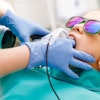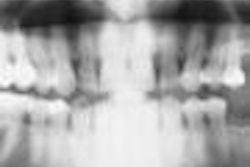ANAHEIM, Calif. - How do you control contrast and density? When do you want a long cone and when a short one? And what's a bisecting angle, anyway? Brad Potter, D.D.S., M.S., a University of Colorado dean and oral and maxillofacial radiology specialist, zoomed in on such confusing x-ray problems at the semiannual meeting of the California Dental Association (CDA) today.
Much about successful x-rays depends on the technique of the operator, Dr. Potter said. He offered helpful tips on contrast and density, distance, angle, bitewings, and patient comfort.
Contrast and density
What can look like an underexposed image may actually be a problem of contrast, Dr. Potter pointed out. For bitewing x-rays, he recommended using darker density films, which work best on hard tissue. They should be combined with short-scale contrast (in other words, set your kVp at the low end of its range).
For periapical x-rays, on the other hand, use lighter density films and long-scale contrast, meaning a higher kVp.
Distance
"In theory, you want to move the film as close as possible to the tooth," Dr. Potter said. "Moving further away you get the tooth blurry." For most exposures, try to achieve a distance between the source and the object (the tooth) of about 16 inches.
That may be hard to achieve with most equipment, because short cones are standard. Look closely at the equipment to find markings that show the distance from the source to the end of the cone. You can special order particularly long cones that will produce sharper images for most exposures. Cones are now called beam indicating devices (BIDs) because most are no longer cone-shaped, Dr. Potter noted.
But for intraoral periapicals and bitewings, a shorter distance between the source and the object works better. That's because the beam spreads out more the farther away it gets from the tooth. For these exposures, you may do better with a short cone.
Angle
"The teeth and the receptor should be parallel to each other," Dr. Potter said. That much is well known. What's not so obvious is how to ensure that they are parallel. One point that's helpful to remember is that teeth are angled differently in different parts of the mouth.
"You must know the long axes of the teeth," he said. The maxillary teeth all tilt facially, which means they splay out a little bit (and the flatter the palatal vault, the greater the tilt). The mandibular anterior teeth are usually facial, while the premolars are straight up and down, and the molars are slightly lingual.
To achieve paralleling, you may have to increase the distance between the film and the tooth. This goes against the standard rule of putting the film as close as possible to the object. "Push the film back as far as possible in the patient's mouth if you are using long-cone paralleling," Dr. Potter said.
Another key is ensuring that the central ray of the x-ray beam is perpendicular to the long axes of the teeth (which means it should also be perpendicular to the plane of the film).
A good film holder can help a lot in maintaining the correct angle.
One instance when the film is not held parallel to the tooth is the bisecting angle technique, in which the plane of the tooth and the plane of the film are bisected by a line that evenly divides them. This line is known as the common side. If the x-ray beam is directed perpendicular to the common side, then it will produce an image of the tooth that is the same size as the tooth, even though the tooth and the image are not parallel.
The concept is difficult to grasp, but a useful one because it is almost the only way to get good images in very small mouths. It's also helpful for shallow palates and during endodontic procedures.
"One problem with the bisecting angle technique is that it's easy to foreshorten," Dr. Potter warned.
If a patient holds the film, he or she should use the thumb for the maxillary arch and the index finger for the mandibular arch.
Bitewings
It's critical that the contacts appear on the x-ray. Don't let patients close their lips because you won't be able to see if they open their teeth. "Always, always the patient should be grinning," Dr. Potter said. Watch out also that the patient doesn't protrude a jaw.
For molars, aim for the maxillary first molar to second molar contact. For premolars, aim for the maxillary second premolar to first molar contact.
Patient comfort
"Just remember we're not in the patient comfort business," Dr. Potter said. Too many x-rays are ruined because the operator let the patient move the film to a more comfortable position.
If the patient seems likely to gag, don't overreact; you may lose the patient's confidence. Do the anterior projections first, because they are less likely to trigger a gag reflex. "Once you set off a gagger," Dr. Potter said, "it's all downhill."
Another key is diverting the patient's attention. It helps to talk a lot -- but don't talk about gagging!
Salt can help too -- "You will be absolutely amazed at how effective this is!" he said. Just sprinkle a few grains on the tongue, then have the patient swallow. As a last resort, try a topical anesthetic, sprayed, not swabbed.



















